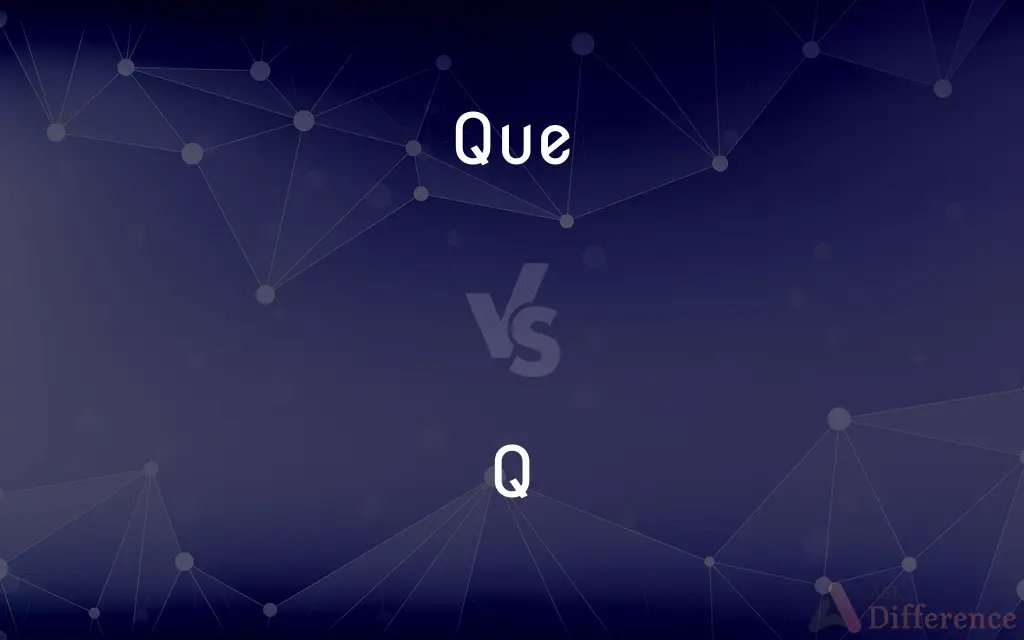Que vs. Q — What's the Difference?
By Urooj Arif & Maham Liaqat — Updated on March 20, 2024
"Que" is a word used in various languages with meanings to translate to "that," "what," or "which" in English, commonly found in questions or relative clauses. "Q" is the 17th letter of the English alphabet, used in abbreviations, names, and as a symbol.

Difference Between Que and Q
Table of Contents
ADVERTISEMENT
Key Differences
In the context of language, "que" serves as a conjunction, pronoun, or part of phrases in languages such as Spanish, French, and Portuguese, playing a crucial role in forming questions, relative clauses, or expressions. For example, in Spanish, "¿Qué hora es?" means "What time is it?" showcasing "que" in a question. Conversely, "Q" is not a word but a letter and symbol, utilized in a vast array of contexts, from abbreviations like "Q&A" (Questions and Answers) to denoting variables in mathematics or physics.
"Que" contributes significantly to the grammar and structure of sentences in the languages it appears in, affecting the meaning and relationships between clauses. On the other hand, "Q" as a letter is fundamental to literacy, representing specific sounds in words and also used symbolically in disciplines such as chemistry (to represent charge) and in pop culture references.
The usage of "que" is tied to linguistic expressions and is defined by the grammatical rules of the languages that employ it. In contrast, "Q" is versatile, appearing in diverse fields such as science, mathematics, literature, and everyday communication, often as an initial or shorthand.
While "que" can change its meaning based on context, syntax, and language, the interpretation of "Q" remains relatively constant, primarily varying when used as a symbol or abbreviation in different specialized fields. This distinction underscores "que's" role in linguistic communication versus "Q's" function as a fundamental component of written language and symbolic representation.
Both "que" and "Q" are essential in their respective domains—linguistic structure for "que" and the alphabet, symbolic representation, and abbreviation for "Q". However, their applications, implications, and relevance vastly differ, reflecting their unique contributions to language and communication.
ADVERTISEMENT
Comparison Chart
Nature
Word in various languages
Letter of the alphabet
Function
Conjunction, pronoun, question formation
Represents sounds, abbreviations, symbols
Usage Context
Questions, relative clauses, expressions
Literacy, science, abbreviations
Linguistic Role
Structural, affects meaning in sentences
Phonetic, symbolic
Variability
Meaning changes with linguistic context
Consistent, with specific symbolic uses
Examples
"¿Qué pasa?" (What's happening?), "lo que" (what/that which)
"Q" in "Question," Q in equations (e.g., Q for heat in thermodynamics)
Compare with Definitions
Que
Forms questions.
¿Qué quieres? translates to What do you want?
Q
Used in abbreviations.
Q&A stands for Questions and Answers.
Que
Integral to specific languages' grammar.
Eso es lo que dijo translates to That's what he said.
Q
Appears in codes and names.
Q as a character in James Bond films.
Que
Used in relative clauses.
El libro que leí means The book that I read.
Q
Alphabet letter.
Q begins words like Question.
Que
Conjunction or pronoun.
Lo que me gusta means What I like.
Q
Denotes quantities in equations.
Q for quantity in math.
Que
Part of expressions.
Qué pena expresses What a pity.
Q
Symbol in science.
Q represents charge in physics.
Que
(rare) q cue.
Q
Q, or q, is the seventeenth letter of the modern English alphabet and the ISO basic Latin alphabet. Its name in English is cue (pronounced ), plural cues.
Que
Clipping of barbeque
Q
The 17th letter of the modern English alphabet.
Que
(South Asia) queue
Q
Any of the speech sounds represented by the letter q.
Que
A half farthing.
Q
The 17th in a series.
Q
Something shaped like the letter Q.
Q
Q A hypothetical lost manuscript, consisting largely of sayings of Jesus, that is believed to have been the source of those passages in Matthew and Luke that bear close similarity to each other but not to parallel passages in Mark.
Q
The seventeenth letter of the English alphabet, has but one sound (that of k), and is always followed by u, the two letters together being sounded like kw, except in some words in which the u is silent. See Guide to Pronunciation, 249. Q is not found in Anglo-Saxon, cw being used instead of qu; as in cwic, quick; cwen, queen. The name (kū) is from the French ku, which is from the Latin name of the same letter; its form is from the Latin, which derived it, through a Greek alphabet, from the PhŒnician, the ultimate origin being Egyptian.
Q
The 17th letter of the Roman alphabet
Common Curiosities
Can "Q" stand for something specific in different contexts?
Yes, "Q" can represent various concepts depending on the context, such as charge in physics or quantity in mathematics.
How is "Q" pronounced in different languages?
The pronunciation of "Q" varies among languages, from the English "kyoo" to the Spanish "cu."
Are there words in English that contain "que" with similar meanings to its foreign counterparts?
Yes, English contains loanwords like "cliché" from French or "barbecue" from Spanish, where "que" appears, but its role differs from its function as a standalone word in those languages.
Why is "que" important in sentence structure?
"Que" is crucial for connecting clauses, forming questions, and expressing relative relationships in sentences, contributing to the complexity and clarity of communication.
Is "que" used the same way in all languages?
While "que" has similar roles in languages like Spanish, French, and Portuguese, its exact usage and meaning can vary based on grammatical rules and context within each language.
How do "que" and "Q" contribute to communication?
"Que" enhances communication by structuring linguistic expressions and forming coherent relationships between ideas in specific languages, while "Q" facilitates written and symbolic representation across various fields.
What challenges do learners face when distinguishing between "que" and similar words in multilingual contexts?
Learners may struggle with understanding the precise function and pronunciation of "que" across languages, as well as distinguishing it from similar words or sounds, especially in languages where "que" has multiple roles or meanings that vary subtly with context.
Can "Q" be used as a standalone symbol outside of abbreviations and equations?
Yes, "Q" can stand alone as a symbol in various contexts, such as representing a character in film or literature, or in brand names and logos, where it is valued for its distinctive appearance.
Are there specific rules for using "Q" in numerical and scientific notation?
In scientific notation, "Q" often follows specific conventions, such as representing electric charge or heat transfer in physics. Its use is governed by the context of the discipline, ensuring clarity and consistency in technical communication.
How does the usage of "que" in questions differ from its function in relative clauses?
In questions, "que" typically introduces a query or uncertainty, asking for information, like "¿Qué es esto?" ("What is this?"). In relative clauses, it links clauses together, specifying or providing additional information about a noun, as in "el libro que compré" ("the book that I bought").
What are some common abbreviations that use "Q"?
Common abbreviations include "Q&A" (Questions and Answers), "FAQ" (Frequently Asked Questions), and "Q1, Q2..." for quarters in a fiscal year.
How has the digital age affected the use of "Q" in communication?
In the digital age, "Q" has gained prominence in online communication, used in social media hashtags, online gaming, and digital branding. Its distinctive shape and rarity in some languages make it a popular choice for creating memorable and impactful online identities.
Share Your Discovery

Previous Comparison
Inshallah vs. Bismillah
Next Comparison
Husband vs. SonAuthor Spotlight
Written by
Urooj ArifUrooj is a skilled content writer at Ask Difference, known for her exceptional ability to simplify complex topics into engaging and informative content. With a passion for research and a flair for clear, concise writing, she consistently delivers articles that resonate with our diverse audience.
Co-written by
Maham Liaqat















































